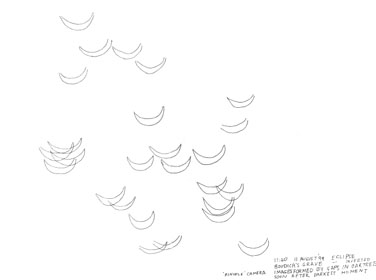13:01:
Beneath the oak through the 'pinholes' of which came these natural photographs of the eclipse of the sun - some of which I traced on paper and some of which I asked a bystander (who seemed to be an artist) to trace for me...
Each hole through the foliage acted like a pinhole camera and cast a photograph of the moon-like the image of the sun eclipsed. By the time the second picture was traced more of the sun became visible as the moon moved out of the way...
So prehistoric people could have experienced the essentials of photography - did they notice this wonder? Surely yes, I should think. See Hollis Frampton's evidence of a pre-historic cinema, below*.


That was two years ago and this is the first occasion at which I've been able to make it known to others - oak tree as camera. The one above me now.
As I look up I see a young man wearing a brown t-shirt and wristwatch taking a photograph of this scene - in the tree shadows at the edge of the prehistoric tumulus or grave mound that just might be the grave of Boadicea, or Boudica (the warrior queen whose army was defeated by the Romans near this part of what is now London).
And then came short muscular man with two Old English Sheepdogs. He paused to throw two balls with attached cords like slings high in the air and far ahead for the dogs to chase after and catch.
As I think about these events I realise that the natural photographs and the slinging of objects for tame dogs to chase could have occurred and been noticed by the Welsh-speaking people who built the tumulus behind me, and also by cave artists of twenty thousand years earlier. So what is new? Only the modern camera and watch of the young man, the surrounding city I can see in the distance, and this little handheld screen on which I can write of these things out of doors and so easily and which by tonight can be read in all parts of the world. What similarities, what differences! And it took so many thousands of years of what was once thought to be progress but is now seen as expansion and connection but with no certainty of being better - only more complex and more comfortable and perhaps more dangerous - and of course we are more numerous. That is the difference. 'Being human' is unchanged I believe.
And it's so good to be a part of all this, whatever you think about it.
* Hollis Frampton's astonishing account of the apparent remains of and references to a prehistoric 'cinema' of Cro-Magnon people in Mexico, using dog intestine for film, lit by sunlight coming through holes in the roofs of domed houses, appears in: Hollis Frampton, 'A stipulation of terms from maternal Hopi' in Afterimage, Double Issue 8/9 Spring, London 1981, pages 64 to 69.